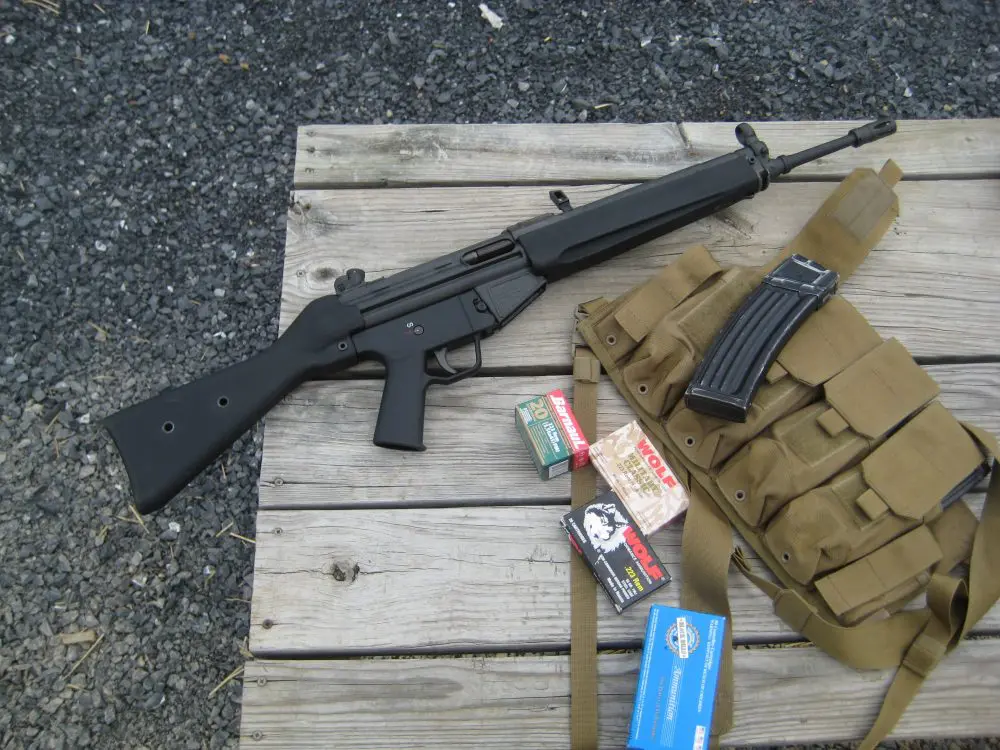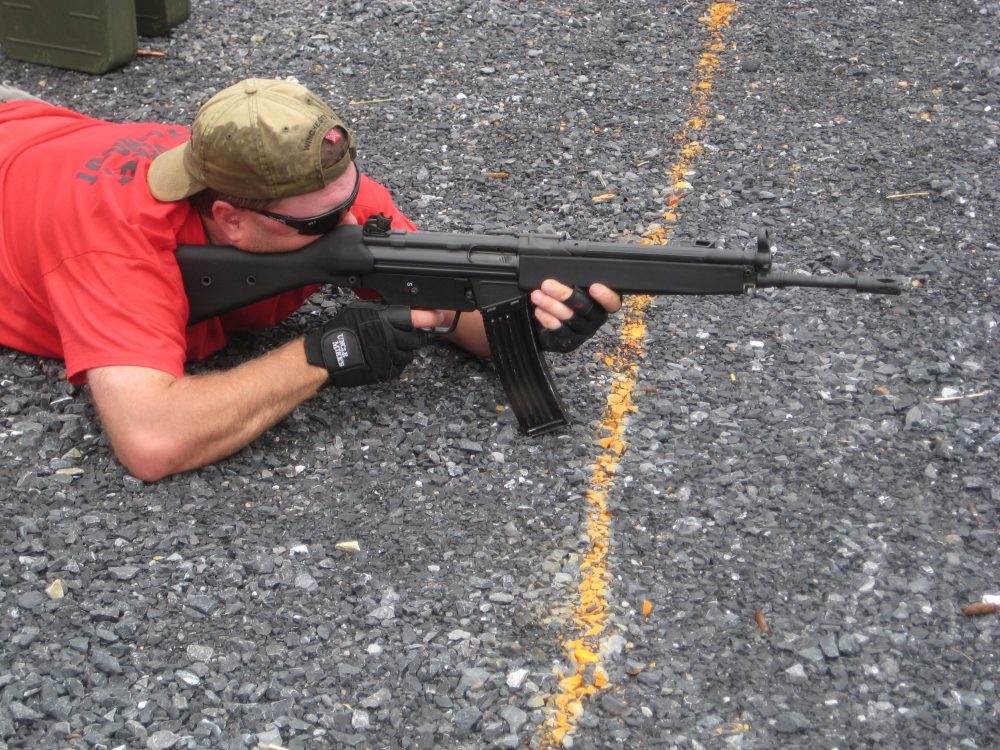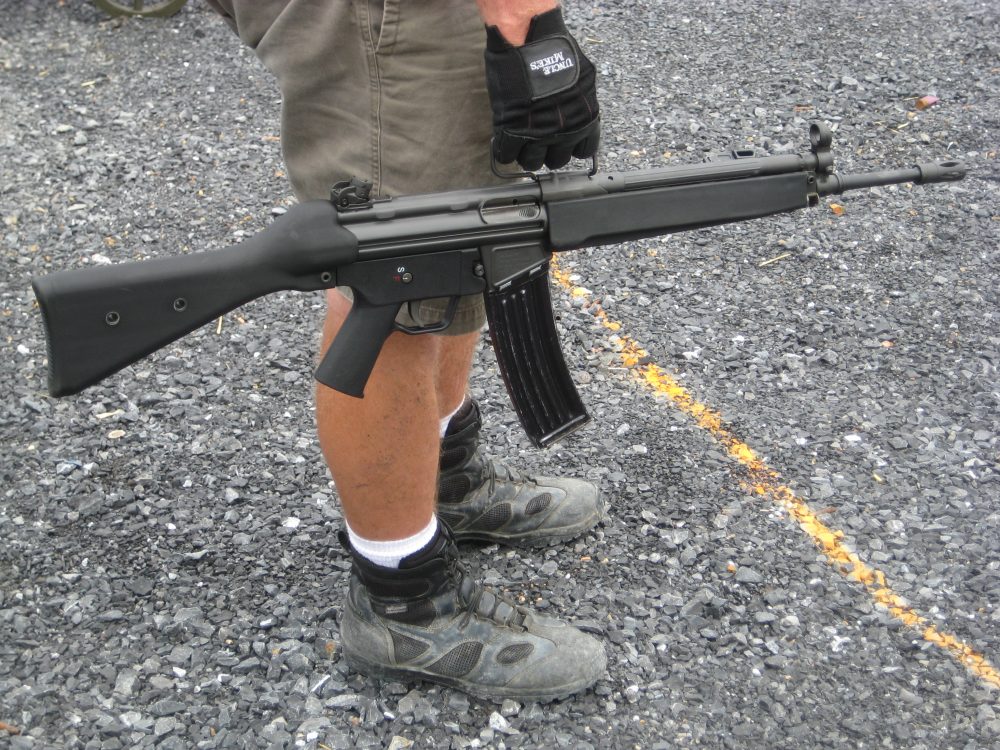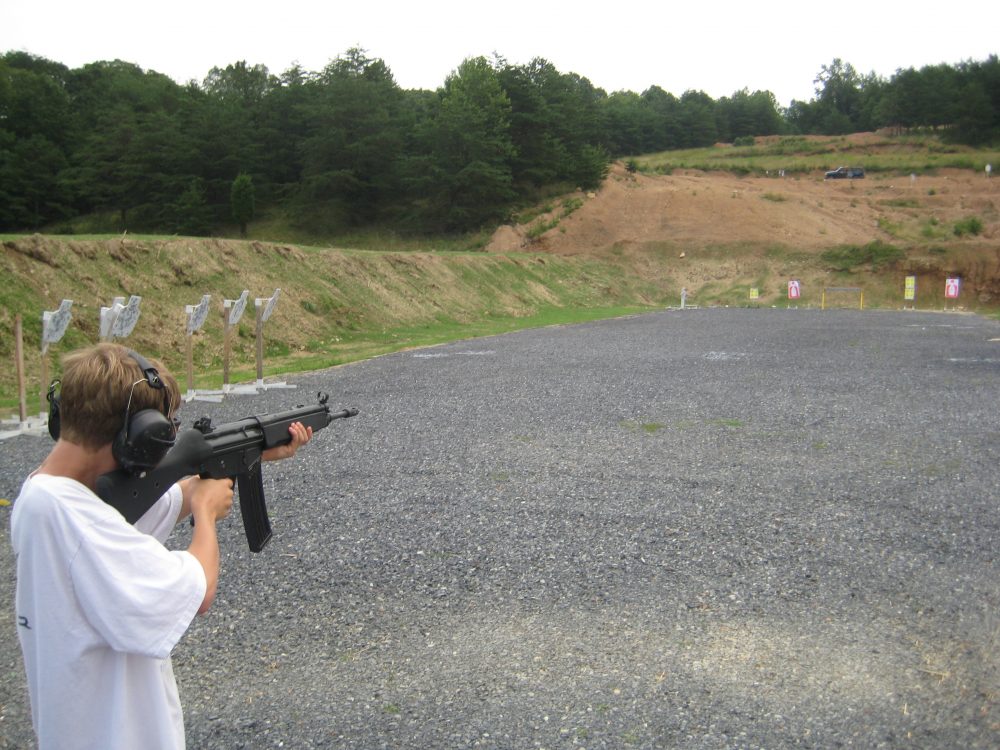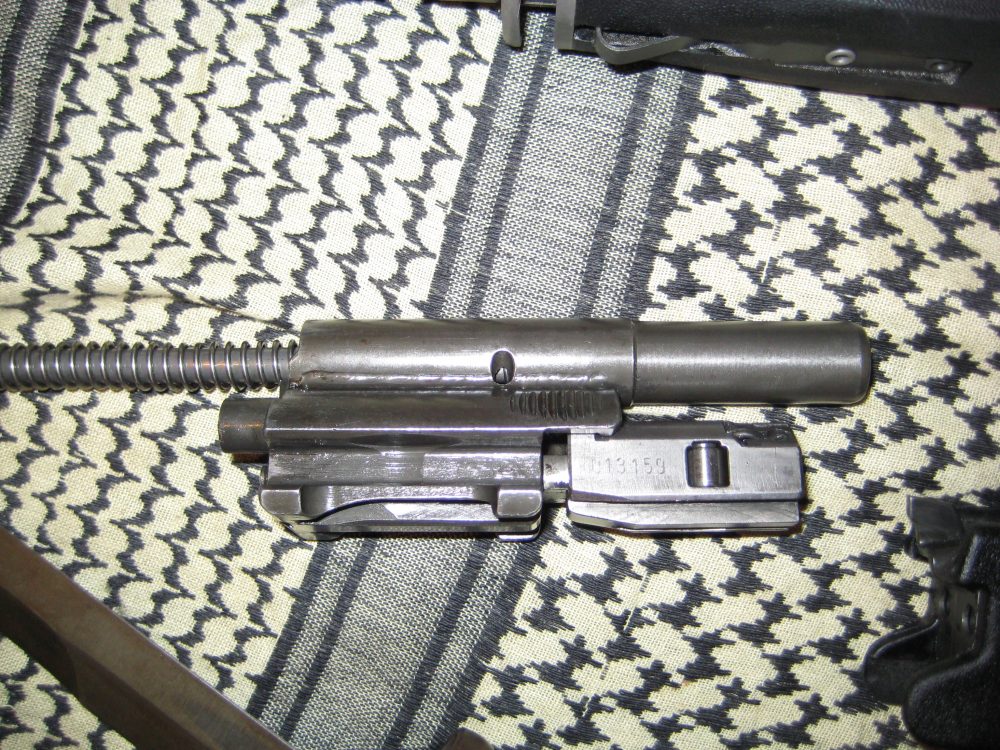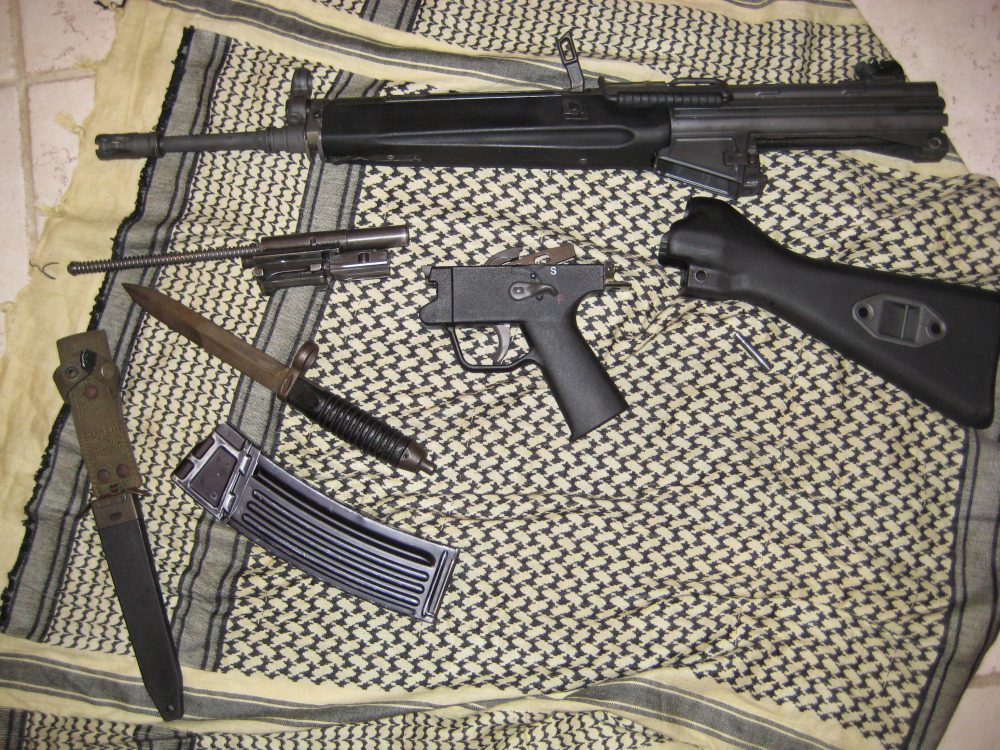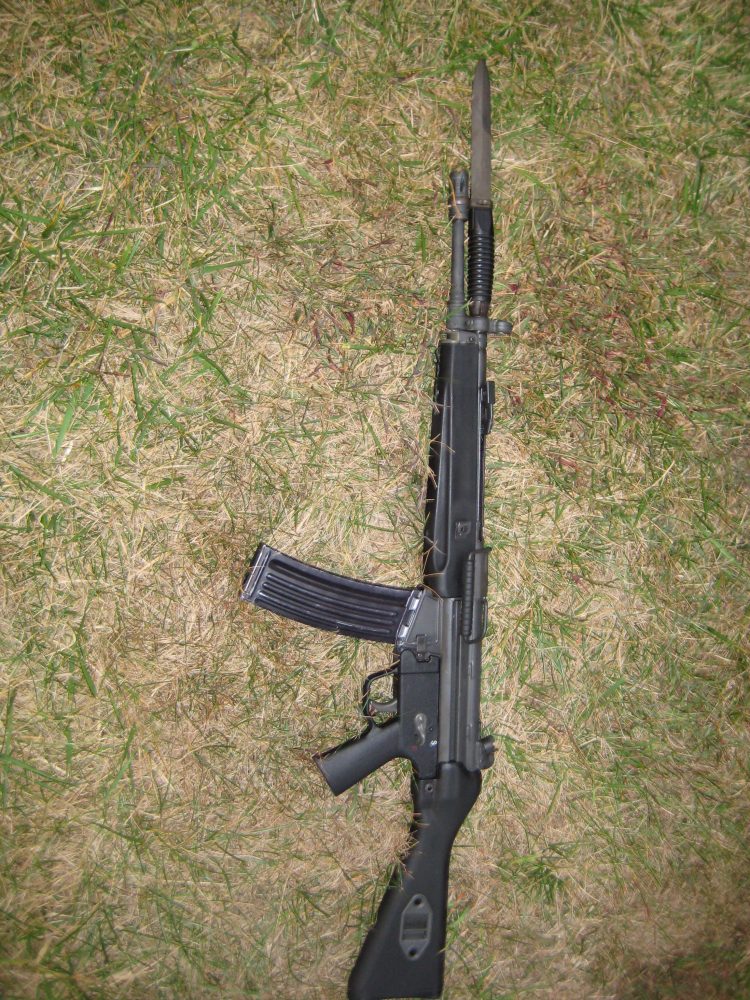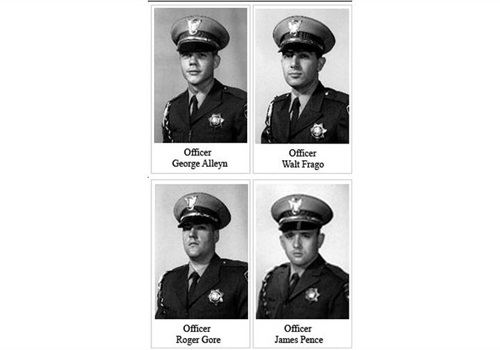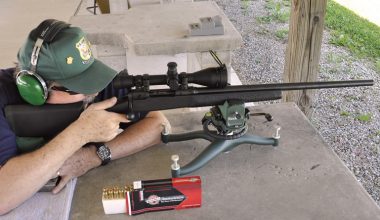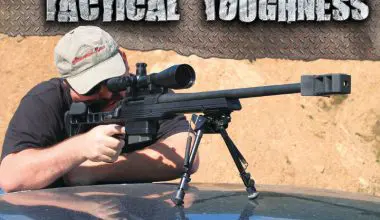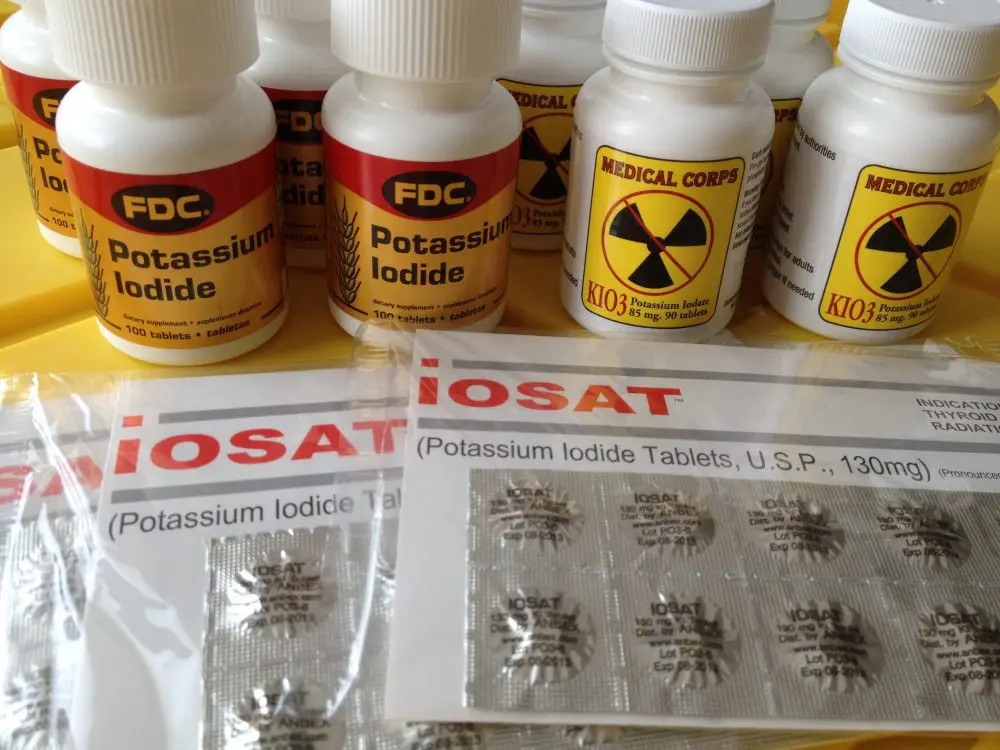It is often said imitation is the sincerest form of flattery. Century International Arms is a major source of U.S.-made versions of well-known weapons, thus allowing the firearms to be distributed stateside.
Century offers semiautomatic sporting versions of AK-47s, Sterlings, PSLs, Golanis (Galils), AK-74s, Tantals, and the CETME. It has just introduced the C93.
The downside of these U.S.-made models is that prior import versions of similar rifles are usually held in much higher regard than the U.S. versions. At times this dismissive attitude is based more on preconceived notions than actual performance. With the gun industry, this is even more the case, due to patents and proprietary processes making exact copies nearly impossible, not to mention the need to comply with U.S. regulations pertaining to parts origination.
Century International Arms C93 rifle with BlackHawk chest rig and 40-round magazines. Wolf, Barnaul, and Black Hills Ammunition were used for range T&E, with no issues encountered in rifle or equipment.
This is amplified even further due to the Century-made weapon needing to be less costly for marketability purposes. If the Century offering is not available at a price significantly lower than the original, then the consumer will simply obtain the original. The U.S. market is skewed slightly, with the firearm importation ban creating artificial shortages. This makes it more worthwhile for Century and other manufacturers to make the effort to recreate arms that normally would not be available.
A firearm must have enough historical significance or performance capability to generate sales to be worthwhile for a company to undertake the effort at introducing it. The C93 has both.
Magazine supported prone was easily obtainable with 40-round magazines with no detriment to reliability. No 25-round magazines were tested due to difficulty in obtaining them.
Table of Contents
C93
It employs a roller-delayed blowback operating system that was first developed in the closing months of World War II in the form of the Mauser StG45 and perfected in the decade after with the CETME. The StG45 was slated to replace the granddaddy of all assault rifles, the StG44, because of its simplicity of manufacture, which resulted in lower cost and greater production potential. The roller-delayed blowback operating system uses recoil forces to manipulate the action and does not rely on ignition gases to operate the weapon. There is no need to tap the barrel to bleed off gas directly into the action or via a piston. This operation method minimizes opportunities for dirt or carbon build-up to affect reliability.
The design also contributes to accuracy by having the barrel truly free-floated and the roller-delayed blowback system avoids sharp recoil impulses derived from direct gas impingement or operating rod systems. The difference in recoil impulse of a rifle utilizing the roller-delayed blowback method versus an AR or AK rifle of the same caliber is noticeable by many shooters.
Century Arms has prior experience with producing U.S.-made versions of delayed roller operating rifles. The C93 seems to be benefiting from this prior manufacturing experience, with limited “teething” issues apparent in the early production runs of the C93.
The C93 weighs 8.2 pounds. A familiar flash hider is installed on the 16.25” barrel, generating a total overall length of 36.5 inches. Sights consist of protected front post and rotating diopter drum rear sight. The C93 comes with an integral side folding carry handle.
Carry handle appears to be a Century addition to the C93. It proved useful, as barrel and cocking handle raceway were too hot to touch at various times during testing.
H&K CONNECTION
The C93 accepts magazines originally made for the HK43 and variants like the HK93.
Since H&K magazines are compatible with the C93, a brief discussion of the history of H&K rifles seems warranted. Arguably the CETME-inspired G3 was one of the most prolific Western export weapons during the Cold War. Based on this popularity, H&K produced a 5.56mm CETME variant labeled the HK33 in 1968, with a semi-auto variant—the HK43—introduced in 1974.
Record sources indicate approximately 200 of the 377 produced HK43s were imported to the U.S. The HK43 name change to HK93 stemmed from various reasons ranging from H&K nomenclature alterations to H&K taking over its own distribution in the U.S. and the need to designate a barrel length change to comply with U.S. regulations related to barrel length.
The HK93 is most commonly fed by 25- and 40-round magazines. Roughly 18,000 HK43/93 rifles were imported before the 1989 Import Ban, as compared to three times as many HK91s. Thus the cost of an original HK43/93 is substantially higher compared to the 7.62x51mm chambered CETME/HK91.
C93 was no problem for young shooter to handle. Diopter rear sight and front post were especially appreciated for accurate fire compared to other rifle sights that feature other types of sights.
RANGE TESTING
Any fighting rifle, regardless of manufacture, must be reliable to be worthy of any consideration. Range testing initially consisted of a functionality test involving firing multiple magazines at several targets in rapid fashion once the sights were verified.
The C93 was then put through its paces on different rifle courses that were set up for a pending law enforcement competition that was to be held at the range. Magazine changes, shooting from the non-dominant shoulder, and unconventional positions helped evaluate the C93. Strings of fire ranged from 15 to 80 rounds with target distances measured in feet out to a couple hundred yards. The C93 handled with perfect reliability through a total of 1,200 rounds during several range visits. The C93 was cleaned between range visits.
Ammunition used for testing consisted mostly of .223 Remington loads and included Barnaul 55-grain, Wolf 55-grain Military Classic, Black Hills Ammunition 55-grain, Federal 55-grain, and Federal 55-grain 5.56x45mm XM193 load.
A BlackHawk chest rig was utilized with range tests with H&K aluminum 40-round magazines. Two magazines and a bayonet are shipped with the rifle. Several more magazines were obtained to aid in the evaluation. Twenty-five-round magazines are available but were not used in this review. As most know, anything associated with H&K is expensive, with 40-round mags costing in the $40+ range and 25-round mags $60 and above.
Accuracy with the C93 was more than acceptable, with the open sights producing two-inch groups at 100 yards. A scope mounted on the C93 would have surely produced better results.
The rotating diopter/drum sight with “V,” “2,” “3,” and “4” settings is conducive to wringing better accuracy out of a rifle compared to AK notch and posts. The sight drum settings were verified at the “V” battle settings along with the 200- and 300-meter marks by consistently ringing steel targets located at the specified distances. The 400-meter aperture setting was not used due to range restrictions.
It was easier for eyes to adapt to the 200-meter aperture on the rear drum than the open “V” setting. Thus the C93’s 200-meter drum setting was primarily used for testing due to being only a few inches high at 100 yards and a few inches low at 300 yards.
Rollers are evident in C93’s bolt assembly. Shooters must avoid pushing the two pieces together, as this will push the rollers out and prevent the bolt from being installed in the rifle without first having to carefully use a pair of pliers to get the rollers back into the bolt.
AMMO
The C93 has a fluted chamber, making C93 spent brass unmistakable in its markings, as is fired brass from all weapons with fluted chambers. A fluted chamber assists in the reliable extraction of empty cases. The fluted chamber is incorporated in most rifles utilizing the roller-delayed blowback operation method, due to the cartridge extraction process beginning almost as soon as the round is fired. This is done by utilizing flowing gases at peak pressure to “float” in between case and chamber walls, weakening the bond between the case and chamber walls and enhancing extraction.
Of late, this takes on more significance now that steel-cased 5.56mm/.223 Rem ammunition is gaining in popularity in comparison with brass as ammunition prices have increased. The 5.56mm/.223 Rem case has minimal taper, which has led to problems with AR-15/M16 rifles operating reliably with steel-cased ammunition, especially as temperatures rise when the volume of fire increases. A comparison to Russian-designed 7.62x39mm and 5.45x39mm cartridges that are more associated with steel cases further illustrates this point, with the Russian rounds employing more tapered case walls.
C93 field disassembled for cleaning. Pushpin in rear stock proved problematic to remove. Hammer and punch had to be employed to drift it out.
OPERATION AND ACCESSORIES
C93 operating controls differ from the AR, M1A, FN FAL, and AK platforms that U.S. shooters are more familiar with. The C93 has a forward cocking handle on the left side of the forearm. It does not have a hold-open feature after the last round is fired. Any reloads starting with “click” or malfunction drills with a failure to fire start with locking the action back with the cocking handle via a recess, removing the magazine, inserting a fresh magazine, releasing the cocking handle, and back into action.
Magazine changes proved an awkward affair at first. This is more an indictment of predominate experience of manipulating AR- or AK-based weapon systems than a criticism of the C93. No reason to debate pros and cons of different systems; a user who chooses a particular rifle needs to be intimately familiar with procedures if he is seriously considering using it in a hostile environment.
H&K aftermarket accessories are a hit-and-miss proposition, with the C93 reflecting the differences in the two designs. The H&K collapsible buttstock seems not to fit without minor modifications due to the receiver rails on the C93 not being of the same specifications. The same is true for the H&K claw scope mounts.
My recommendation is to try out any accessories on the C93 before making any sizable investment in H&K collapsible stocks or scope mounting rails for the C93. The rear stock was easily removed only after drifting out the crosspin with a brass punch and hammer. The trigger group dropped away easily, allowing for unhindered access to the bore for cleaning. The bolt carrier and recoil spring come out of the back of the receiver.
C93 bayonet affixes above the barrel. Rifle ships with bayonet and two 40-round magazines.
U.S. MANUFACTURE AND AVAILABILITY
Based on supposition and research, it appears the barrel, trigger group, pistol grip, and carry handle can be attributed to U.S. manufacture with some certainty, with other components open to debate. Century Arms would not elaborate on this subject when approached.
The C93 will be the only way many will have the opportunity to handle this type of rifle because of price or diminishing availability.
The Century C93 proved a reliable and accurate rifle for this test based on any standard of evaluation—original or U.S.-made version. Not much more can be asked of a rifle that has its origins as a main battle rifle from the closing days of World War II.
SOURCES:
ATK/Federal Cartridge Company
Dept. S.W.A.T.
900 Ehlen Drive
Anoka, MN 55303
(800) 322-2342
www.federalpremium.com
BlackHawk! Products Group
Dept. S.W.A.T.
6160 Commander Pkwy
Norfolk, VA 23502
(757) 436-3101
www.blackhawk.com
Black Hills Ammunition
Dept. S.W.A.T.
P.O. Box 3090
Rapid City, SD 57709
(605) 348-5150
www.black-hills.com
Century International Arms
Dept. S.W.A.T.
430 South Congress Ave. Suite 1
Delray Beach, FL 33445
(800) 527-1252
www.centuryarms.com
Stonewall Arms
Dept. S.W.A.T.
2438 Valley Ave.
Winchester, VA 22601
(540) 535-2190
www.stonewallarms.com
Wolf Ammunition
Dept. S.W.A.T.
P.O. Box 757
Placentia, CA 92871
(888) 757-9653
www.wolfammo.com
